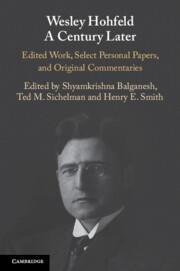Book contents
- Wesley Hohfeld A Century Later
- Wesley Hohfeld A Century Later
- Copyright page
- Contents
- Figures
- Tables
- Contributors
- Introduction: Hohfeld at the Crossroads
- Some Fundamental Legal Conceptions as Applied in Judicial Reasoning
- Selected Personal Papers of Wesley Newcomb Hohfeld
- Part I Philosophy of Jural Relations
- 1 Hohfeld on Legal Language
- 2 Rights Correlativity
- 3 Hohfeld and Rules
- 4 Logic and the Life of the Law (Professor): A Logocratic Lesson from Hohfeld
- Part II Hohfeld and Property
- Part III Hohfeld and Equity
- Part IV Hohfeldian Complexities
- Part V Hohfeld and Society
- Index
1 - Hohfeld on Legal Language
from Part I - Philosophy of Jural Relations
Published online by Cambridge University Press: 14 July 2022
- Wesley Hohfeld A Century Later
- Wesley Hohfeld A Century Later
- Copyright page
- Contents
- Figures
- Tables
- Contributors
- Introduction: Hohfeld at the Crossroads
- Some Fundamental Legal Conceptions as Applied in Judicial Reasoning
- Selected Personal Papers of Wesley Newcomb Hohfeld
- Part I Philosophy of Jural Relations
- 1 Hohfeld on Legal Language
- 2 Rights Correlativity
- 3 Hohfeld and Rules
- 4 Logic and the Life of the Law (Professor): A Logocratic Lesson from Hohfeld
- Part II Hohfeld and Property
- Part III Hohfeld and Equity
- Part IV Hohfeldian Complexities
- Part V Hohfeld and Society
- Index
Summary
Wesley Newcomb Hohfeld is well-known for maintaining that various terms in law – “rights,” most prominently – confusingly designate a number of quite different legal relationships. But what is the source of the confusion? Is it that the terms themselves are vague or ambiguous, thus making them susceptible to multiple meanings? Or is it that the lawyers, judges, and commentators who use such terms are loose thinkers, needing careful analysis in order to clear their minds and their thoughts? Or is it something else?
- Type
- Chapter
- Information
- Wesley Hohfeld A Century LaterEdited Work, Select Personal Papers, and Original Commentaries, pp. 99 - 111Publisher: Cambridge University PressPrint publication year: 2022
- 1
- Cited by

